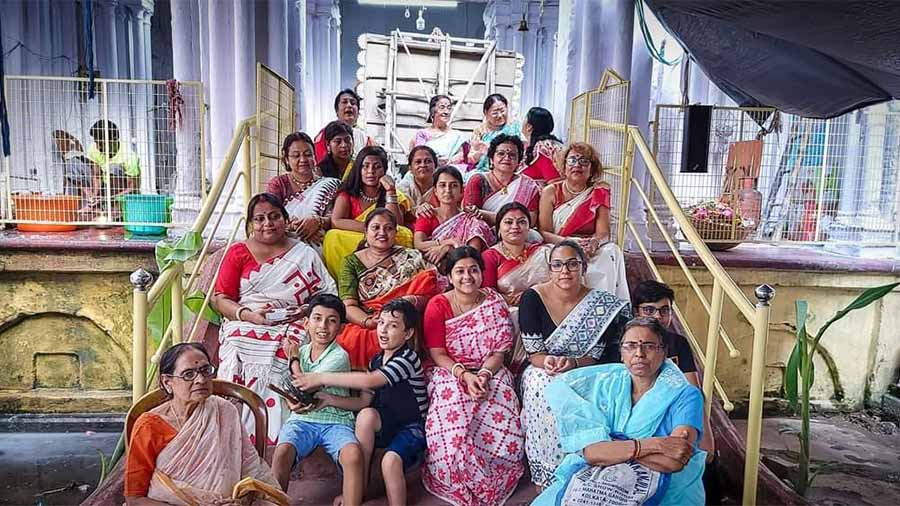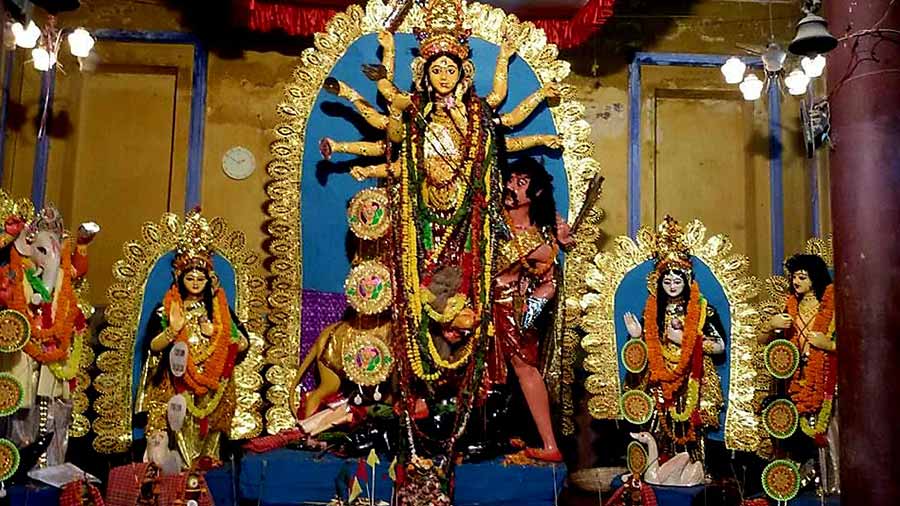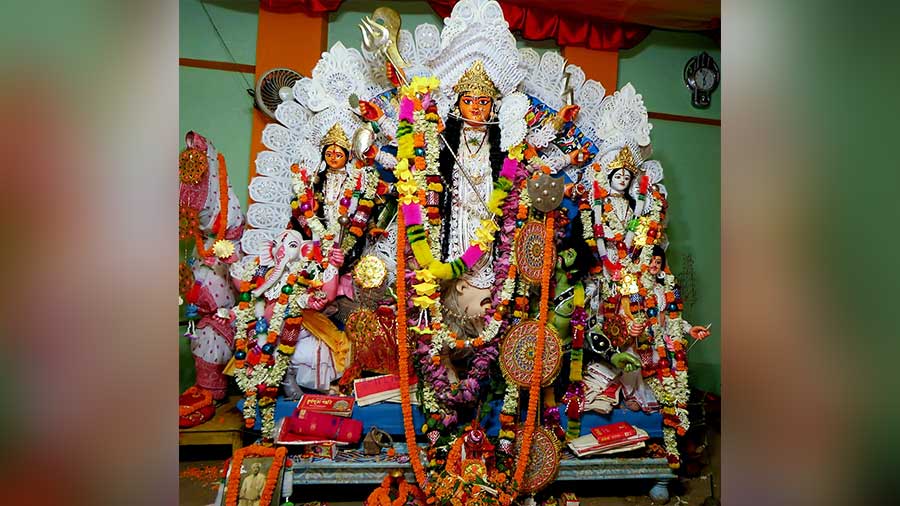The beats of the dhaak, so intrinsically associated with Durga Puja everywhere, are missing at the Ghosh Nibash pujo at Nanda Ghosh Lane in Chandernagore.
The 227-year-old family puja has been silently carrying on its carefully nurtured legacy with its homely fusion of tradition, rituals and a familial bonhomie.

The Chandi ‘mandap’ facing the ‘uthon’ Agnideb Bandyopadhyay
As one enters Ghosh Nibash, the facade gives way to a spacious uthon (inner courtyard) and the house built around it. Subhash Ghosh, 78, who helms the family at present, lives with his wife and his daughter’s family in a new house adjacent to the ancestral address. Built in the latter half of the 18th century, the house holds a rustic charm with its exposed bricks, Roman composite columns, frescoes, carved wooden windows and a comforting and consuming earthly scent. “If one looks carefully at the architecture and how the pillars hold the house together, they can get a clear idea of the late 18th century’s Franco-Roman stylistic imprints on the house and the Chandi mandap,” said Ghosh.
Gorachand Ghosh laid the foundation of the house and started the pujo sometime around 1790. It can be roughly traced back to 1795, with oral stories, architectural structures and documents standing testimony. “Gorachand Ghosh had descendants branching out into two lines. As I’ve heard from my grandfather, the pujo was organised by the other branch till 1915, when my grandfather took over as they emigrated to other parts of Bengal,” added Ghosh.

Exposed bricks and late 18th century columns add to the rustic charm Agnideb Bandyopadhyay
The Ghosh family holds its traditions extremely close when it comes to Durga Puja. The uniqueness of the chalchitro behind the idol can be observed in its triple-crowned single structure and the three etchings of Radha Krishna, Jagaddhatri and Kali on each of the three crowns, which have remained the same since its inception. The puja at Ghosh Nibash also follows the Bishuddho Siddhanto Mot on the lines of Belur Math. “I can remember at least two instances, where our pujo was held a month apart from everybody who follows the Gupta Press Panjika,” said Ghosh.
Ghosh Nibash also prides itself in the tradition of food that has been maintained since the very beginning. For Manidipa Ghosh Mandal, Ghosh’s daughter, the food arrangements have always been an intrinsic element of their pujo. “Unlike other pujos where the tradition of annya bhog is followed, we have always had shukno bhog, cooked without salt. Kumror chhokka and dhokar daalna are two other preparations that have always been part of our elaborate arrangements over the four days. The only day we have fish is on Dashami. The women of the household have fish before boron, a tradition that has been followed since the inception of the puja. Even if we don’t have time to have lunch owing to the last-minute arrangements on Dashami, we make sure, we taste a bit of the cooked fish before making our way to the thakur dalaan.”
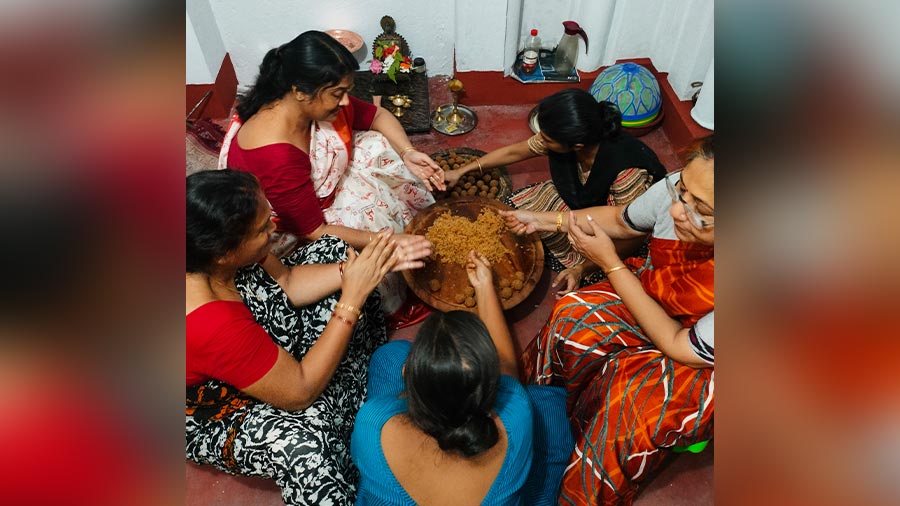
The Ghosh’s tradition of making ‘naaru’ on Mahalaya Agnideb Bandyopadhyay
A tradition that was very much alive and well-known in the neighbouring towns was the Ghosh’s practice of Doridro Narayan Bhojon on Saptami, Ashtami and Navami. “The way my grandfather made sure we held on to the tradition was unthinkable. He made sure none of us looked at the tradition as a form of helping the needy, but as a form of service to guests that defined the essence of pujo at Ghosh Nibash. Hundreds flocked to our house over the three days, with the seating arrangements alone spilling on to the main street,” said Ghosh. It came to a sad but essential halt in 1962, with the Indo-China War bringing in an acute shortage of ration and was eventually discontinued from the following year.
The women at Ghosh Nibash have always been at the centre of the pujo. Gouri Ghosh, Subhash’s wife, who’s been here since 1972, feels the camaraderie among the women of the households everything together. From an elaborate naru-making ritual, maintaining the schedule, monitoring the kitchen, and leading up to boron on Dashami. “We have a unique tradition we follow after bhashan. Once we are blessed with the shantir jol, the women of the household stand in a circle on our uthon, with every young member of the family carrying a bag to collect a mishti from everyone they take blessings from. And we stay there, till everybody is done. It's been a dear tradition for our family,” Gouri Ghosh said.
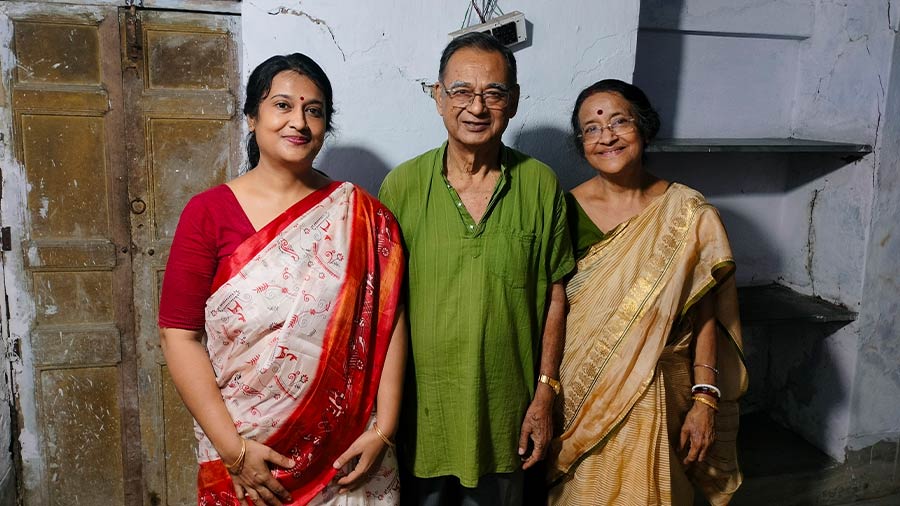
(From left) Mandipa Ghosh Mandal, Subhash Ghosh and Gouri Ghosh Agnideb Bandyopadhyay
Like everything that passes through the turnstiles of time, Puja at Ghosh Nibash has evolved and faded in equal proportions over years. Stuck in the corporate clockwork, half of the extended family find it difficult to manage time to come home during Pujo. Subhash also feels that ease of access to money has also worn down the intensity of the wait and the traditions. "In our childhood, there wasn't a lot of money around. Every rupee mattered to us. And we never had a board or a fund to channel the money. Everybody donated whatever they could, but to Maa Durga’s grace, we have never had to think of money hindering Pujo. Now there's money everywhere, but the people, the craze and the connections are nowhere to be found. Pujo at Ghosh Nibash continues to breathe and I hope our children nurture the legacy with love and care.”
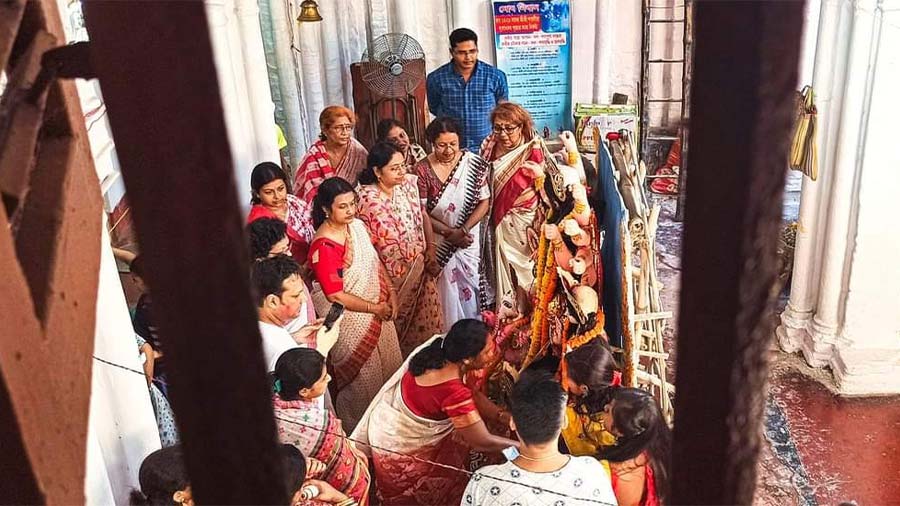
Women members during the ‘boron’ of the goddess Agnideb Bandyopadhyay
Manidipa, a teacher and a headmistress at a government school, who faces the reality of situations and rituals with pragmatism, feels change defines evolution, but not at the cost of human connection. “It’s love and togetherness that define Ghosh Nibash. The foundation of this house is a heart-warming mix of the sounds of laughter, kids running around and adda filled with joy.” But for her, change is inevitable. For instance, the house has not been graced by the sound of the dhaak after something ominous happened in its early days. “It’s time we do away with these superstitions. I have decided 2023 will be the first time in a couple of centuries that Ghosh Nibash will be graced with the sound of dhaak,” she added with a smile.
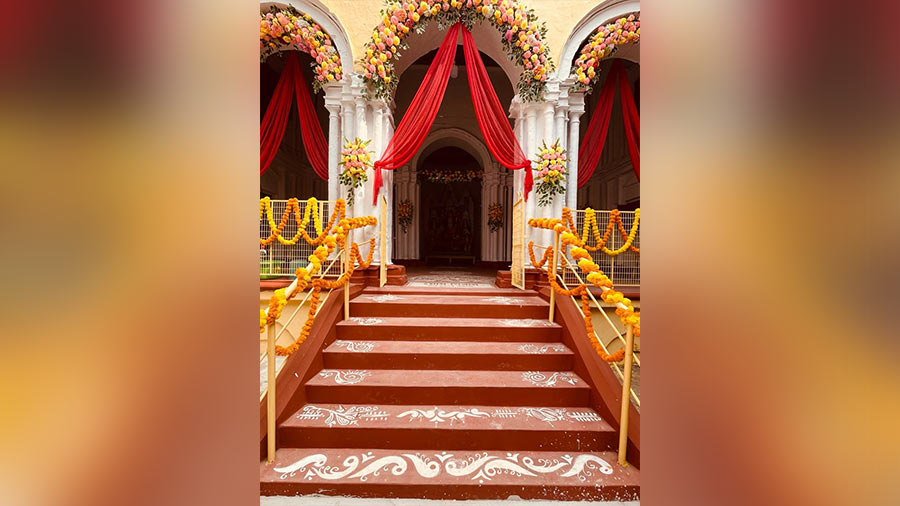
The well-decorated ‘thakur dalan’ Agnideb Bandyopadhyay
